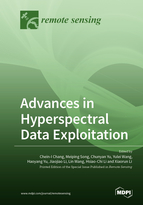Advances in Hyperspectral Data Exploitation
A special issue of Remote Sensing (ISSN 2072-4292). This special issue belongs to the section "Remote Sensing Image Processing".
Deadline for manuscript submissions: closed (30 June 2022) | Viewed by 71103
Special Issue Editors
Interests: hyperspectral/multispectral image processing; medical imaging
Special Issues, Collections and Topics in MDPI journals
Interests: hyperspectral image processing; artificial intelligence; remote sensing
Special Issues, Collections and Topics in MDPI journals
Interests: remote sensing image processing
Special Issues, Collections and Topics in MDPI journals
Interests: hyperspectral image processing; multi-source remote sensing image fusion; artificial intelligence
Special Issues, Collections and Topics in MDPI journals
Interests: models and algorithms for hyperspectral image processing; analysis and applications
Interests: remote sensing image processing; spectral super-resolution; 3D computer vision; deep learning
Special Issues, Collections and Topics in MDPI journals
Interests: hyperspectral image processing; automatic target recognition; band selection and real-time image processing
Interests: hyperspectral and medical image processing; vital sign signal processing
Special Issue Information
Dear Colleagues,
Hyperspectral imaging technology has advanced toward a new era, where many promising hyperspectral image processing techniques have found potential in widespread applications. Particularly, in recent years, hyperspectral imaging has expanded its data exploitation in various areas: geology, agriculture, forestry, fishery, environmental monitoring, etc. Thus, the aim of this Special Issue is to publish new ideas and findings in hyperspectral data exploitation. Specifically, the following areas are of particular interest.
- Developing new ideas and techniques:
- Anomaly detection, subpixel target detection;
- Band selection, dimensionality reduction, data compression;
- Compressive sensing;
- Low rank and sparse representation;
- Unsupervised learning, active learning, deep learning;
- Data/sensor/information fusion;
- Endmember finding, extraction, variability;
- High performance computing;
- Hyperspectral image classification;
- Hyperspectral unmixing;
- Algorithm design, architecture, and implementation:
- Real-time processing;
- Parallel processing;
- GPU/FPGA;
- Applications of hyperspectral imaging:
- Agriculture including detection of diseases, pesticide residuals for produces and crops;
- Environmental monitoring including toxic wastes, water pollution, oil spills, and sewage;
- Forest and plantation including species detection and classification.
Prof. Dr. Chein-I Chang
Dr. Meiping Song
Dr. Chunyan Yu
Dr. Yulei Wang
Dr. Haoyang Yu
Dr. Jiaojiao Li
Dr. Lin Wang
Dr. Hsiao-Chi Li
Dr. Xiaorun Li
Guest Editors
Manuscript Submission Information
Manuscripts should be submitted online at www.mdpi.com by registering and logging in to this website. Once you are registered, click here to go to the submission form. Manuscripts can be submitted until the deadline. All submissions that pass pre-check are peer-reviewed. Accepted papers will be published continuously in the journal (as soon as accepted) and will be listed together on the special issue website. Research articles, review articles as well as short communications are invited. For planned papers, a title and short abstract (about 100 words) can be sent to the Editorial Office for announcement on this website.
Submitted manuscripts should not have been published previously, nor be under consideration for publication elsewhere (except conference proceedings papers). All manuscripts are thoroughly refereed through a single-blind peer-review process. A guide for authors and other relevant information for submission of manuscripts is available on the Instructions for Authors page. Remote Sensing is an international peer-reviewed open access semimonthly journal published by MDPI.
Please visit the Instructions for Authors page before submitting a manuscript. The Article Processing Charge (APC) for publication in this open access journal is 2700 CHF (Swiss Francs). Submitted papers should be well formatted and use good English. Authors may use MDPI's English editing service prior to publication or during author revisions.
Keywords
- Band selection
- Data fusion
- Hyperspectral data exploitation
- Hyperspectral image classification
- Hyperspectral imaging
- Spectral unmixing
- Target detection










